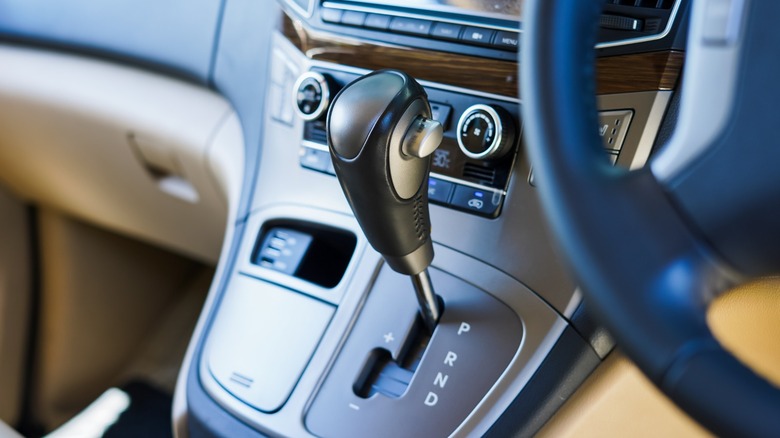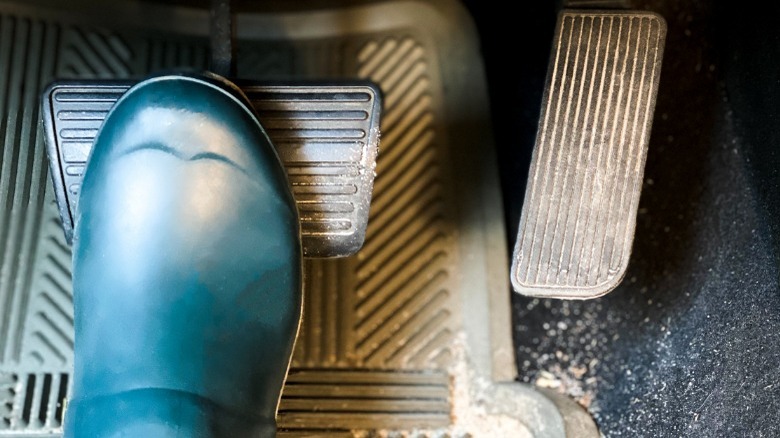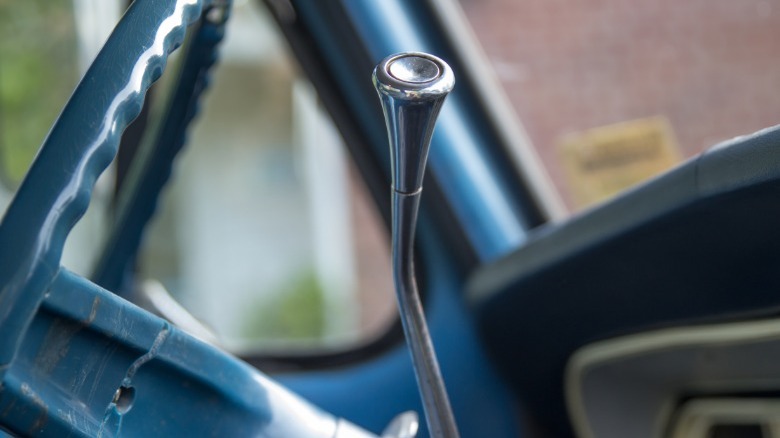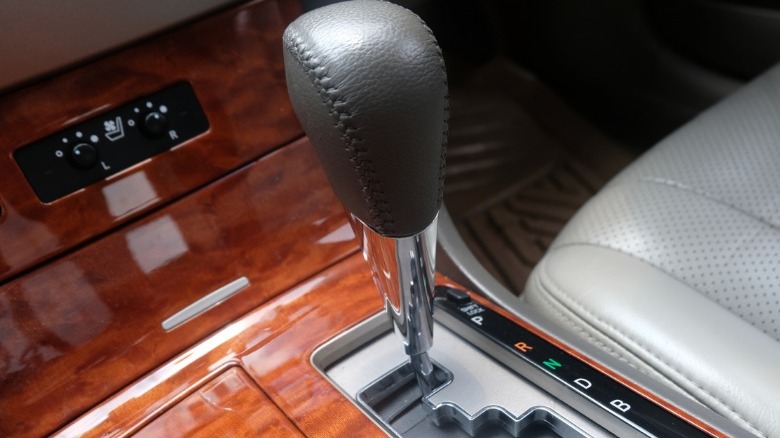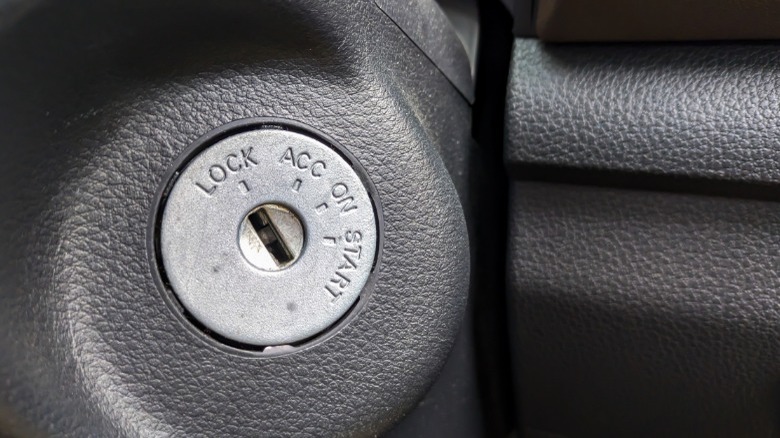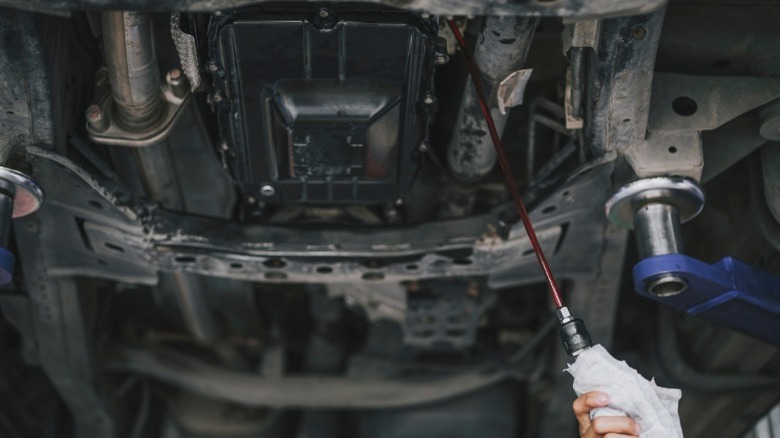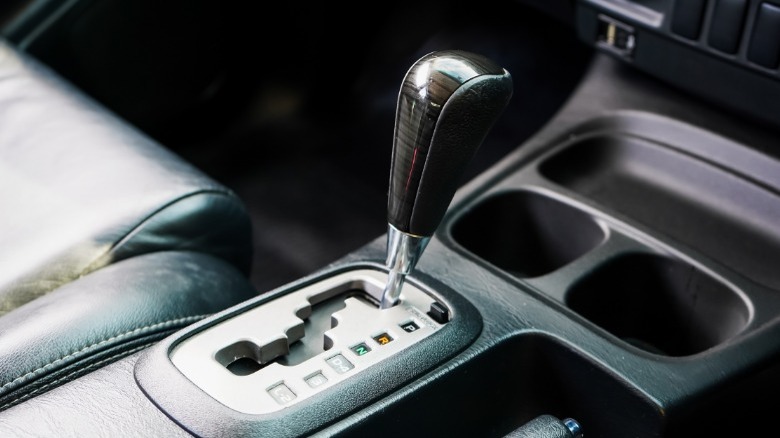Gear Shift Stuck In Park? Here Are The Possible Reasons
If you drive a car with an automatic transmission, chances are you're used to and fond of the seamless way in which these devices allow us to drive. There's no shifting manually, no need to perfectly time your use of the clutch pedal, and no awkward stalls as you learn to operate the shift knob, clutch, and gas pedal simultaneously. But for all the great things about automatic transmissions, they're not bulletproof, and there are various ways that these devices can fail.
One particularly frustrating automatic transmission problem that many drivers may experience at one point or another is an inability to shift into gear. That issue commonly takes the form of a gear shifter that you cannot move out of park. Several problems can cause this malfunction, including things as basic as low transmission fluid and more complicated issues like a faulty ignition switch. If you experience this problem yourself, you'll most likely need the help of a professional mechanic to diagnose the root cause. But even if you're a complete car novice, it's not a bad idea to familiarize yourself with some of the most common reasons for this problem. Doing so can prepare you for unexpected issues and help increase your car knowledge overall.
Fortunately, we here at SlashGear can help. As a former professional auto repair technician and lifelong car enthusiast, I'll break down the most common causes of this issue and a few potential fixes. So, from malfunctioning brake light switches to damaged shift cables and more, here are the most common reasons for your gear shifter to be stuck in park and a few potential fixes.
Damaged brake light switch
A faulty brake light switch is one of the most common reasons that your gear shifter may be stuck in park. The brake light switch performs a few functions. The main job of the switch is to turn your car's brake lights on when you depress the brake pedal. However, the switch does much more than that, and it's also a safety mechanism that plays a key role in various other systems. In vehicles with automatic transmissions, drivers must press the brake pedal to shift out of or into park. If the sensor fails, it will be unable to send a signal to the shift interlock solenoid, meaning you won't be able to move your shifter out of park, even if you're pressing the brake pedal.
A faulty or malfunctioning brake light switch is a common cause of a shifter that you can't move out of park, but the same issue can be caused by a blown brake light fuse. Either way, the fix is relatively simple: replace the worn-out or broken part. A brake light switch replacement should cost around $100, depending on your vehicle and the labor rates in your area. A fuse replacement will likely cost less than $50. Both fixes are relatively simple and straightforward, and you can DIY them if you want to save some cash. A fuse replacement will be significantly easier and only requires you to replace the old fuse by accessing the fuse box under the hood or inside your car's cabin. A brake light switch replacement is also pretty simple, and, in most cases, only involves replacing the switch located under the dash near the brake pedal.
Faulty shift interlock solenoid
Outside of a damaged brake light switch, a faulty or malfunctioning shift interlock solenoid is another one of the most common causes of a shifter stuck in park. The shift interlock solenoid works with the transmission control module (TCM) and is responsible for ensuring that your car stays in park unless the brake pedal is depressed. If the solenoid fails, the TCM will be unable to disengage the park gear, resulting in an inability to shift into a driving gear. The solenoid is typically located underneath the center console in vehicles with a center console shifter, and beneath the steering column in vehicles with column shifters.
If the solenoid fails, you'll need to replace it. However, it's worth noting that the solenoid can fail due to electrical issues like an open circuit. Your mechanic should test for electrical problems before replacing the solenoid. But if you want to do it yourself, you'll need to check the solenoid with a multimeter or test light while the ignition is ON and the brake pedal is depressed. If the solenoid is receiving power, then there's a deeper electrical issue which you or a professional will need to identify — replacing the solenoid alone will not fix the problem in this case.
That said, a shift interlock solenoid is a fairly inexpensive replacement. If you pay a mechanic to do the work for you, you should expect the cost to fall somewhere between $150 and $250, depending on your car and local labor rates. Performing the job yourself will save you some cash, as you'll only need to buy the new solenoid, which should cost between $50 and $100.
Damaged shift mechanism
In the past few years, some automakers have begun building vehicles with automatic transmissions that use electronic gear shifters, meaning they rely on buttons and electric interfaces to actuate gears inside the transmission. In contrast, the vehicles built in previous decades and a large number of the cars on the road today — including many modern vehicles — have mechanical shift mechanisms. Cars with mechanical shifters rely on a lever or shift knob and a cable to physically move your transmission between gears like park, reverse, and drive. Over time, the cable and accompanying components can develop damage, stretch, or break entirely. If this occurs, you may be unable to shift out of park, or into any other gear.
Like many of the other issues described here, this problem requires replacing the broken or damaged part. If you visit a professional mechanic to have your shift cable replaced, you'll likely pay around $350, depending on your car's make and model and the shop's labor rates. Performing the service yourself allows you to save on labor fees. However, the job is more complex than many of the other fixes on this list. The job requires removing the center console or steering column to access the cable, disconnecting the cable from the transmission, and routing a new cable between the two locations. It is possible to DIY your shift cable replacement, but you will need a variety of tools, and you should have at least some rudimentary knowledge of automotive transmissions and mechanics.
Malfunctioning ignition switch
Another less common reason for a gear shifter to get stuck in park is a faulty or malfunctioning ignition switch. The ignition switch is the component that allows you to start your car's engine. It's located near the steering wheel and works in tandem with your ignition lock cylinder — when you slide your key into the ignition and turn, it places pressure on a series of tumblers and pins inside the cylinder, activating the switch and sending electrical energy to your vehicle's starter motor, spark plugs, and more. If the ignition switch fails, it may be unable to send the appropriate electrical signals to the shift interlock solenoid, which may prevent you from moving your shifter.
The fix requires you to replace the switch, which can be a complicated procedure. Depending on your vehicle, you may have to remove the steering wheel to access the ignition switch. That can be pretty advanced, and it may be too technical for car novices. That said, you can DIY an ignition switch replacement. However, if you plan to perform the job yourself, you will need a well-rounded tool kit, and it will help if you have access to a vehicle-specific repair manual or detailed electrical diagrams explaining how to wire the new switch. If you don't feel like attempting the repair yourself, don't worry — replacing an ignition switch is not overly expensive. If you choose to visit a professional for the service, you should expect to pay between $200 and $250, depending on your car and the shop's labor rates.
Low or contaminated automatic transmission fluid
One of the simplest reasons that your shifter may be stuck in park — or any other gear — is a lack of transmission fluid or contaminated fluid. Automatic transmissions function, in part, by using hydraulic fluid to actuate things like clutch packs, the torque converter, and solenoids. If the fluid level is too low or is contaminated with debris, the transmission may not be able to function properly. Low fluid levels or dirty fluid can cause things like overheating, rough shifting, strange noises, and an inability to shift gears. If you drive your car without adequate transmission fluid for long enough, you're likely to cause severe and costly damage.
Fortunately, low or dirty transmission fluid is one of the less severe issues that can cause your gear shifter to be stuck in park. Your transmission fluid may be dirty or the level may be too low for many reasons, including a few serious issues. However, putting a band-aid on those issues to prevent more immediate damage is fairly simple. In most cases, you simply need to top off your fluid level. If your vehicle has a transmission fluid dipstick in the engine bay, this process is as easy as adding more fluid until the level is within the appropriate range. In the case your vehicle has a sealed transmission — i.e., one that does not have a dipstick — you'll have to add more fluid from below the car using a pump. If your fluid is contaminated, you'll likely need to flush your transmission and refill it with clean fluid. While none of those fixes are overly complicated or expensive, they may be too difficult for car novices, and you may need to visit a professional for help.
How to unlock a stuck gear shifter
We've covered various reasons why your car's gear shifter may become locked and stuck in park. Unfortunately, it's a relatively common problem with modern vehicles, and the issues discussed here only represent the usual suspects when it comes to this malfunction. However, there are other problems that can cause your gear shifter to become stuck in park. The good news is that there is a fairly simple way that you can unlock your shifter if it happens to you. Keep in mind that this fix is only a band-aid solution — it may unlock your gear shifter, but it will not fix the root problem. Also, it may not work for every car. However, if you drive a moderately modern vehicle, chances are this fix may help you. Here's how it works.
First, activate your car's emergency or parking brake. Then, place your key into the ignition and turn it to the ON position but do not start the engine. Near your gear shifter, you should see a small slot or plastic cover with a notch to help you remove it. Remove the plastic cap to reveal a small hole. Insert a slim tool, like a screwdriver or another key, into the hole and push down. While pushing your tool into the crevice, press your brake pedal. Finally, press the button on your gear shifter and attempt to move it out of park.
Remember, the above process represents a quick band-aid fix. If your car's gear shifter is stuck, you should visit a professional for a complete inspection and diagnosis, especially if it's an issue that you experience frequently.
